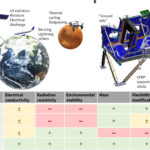2023-03-25 アメリカ合衆国・ロスアラモス国立研究所
(LANL)

・ LANL が、コロイダル量子ドット(QDs)による高輝度発光素子の主要な課題を克服し、光励起レーザーと高輝度 LED の両機能を提供するデバイスを開発。
・ 集積エレクトロニクスやフォトニクス、光インターコネクト、ラボ・オン・チッププラットフォームやウェアラブルデバイス等の多岐にわたる技術への影響が期待され、電気励起によるコロイダル QDs レーザーやレーザーダイオードの開発に向けた重要なマイルストーンとなる。
・ QDs の極微細な「量子サイズ」の効果が、多様な波長のレージング線の調整や、多様な波長でのレージングを支える多色のレーザー媒質設計を可能にする。
・ QDs レーザーダイオード研究では、溶液プロセスで作れる材料による電気励起レーザーや増幅器の実現が目標とされる。あらゆる基板への整合性、スケーラビリティーや従来のシリコン回路を含むオンチップエレクトロニクス・フォトニクスへの集積が容易であることなどから世界で開発が進んでいる。
・ 新デバイスでは、QD 層が電気駆動による発光素子の役割を担う。500A/㎠を超える高い電流密度でこれまでにない 100 万 cd/㎡超の高輝度を達成。デイライトディスプレイ、プロジェクターや信号機等のアプリケーションに最適となる。
・ 同 QD 層はまた、効率的で光利得の大きな導波管増幅器としても機能する。電気励起に要する電荷輸送層等を含んだ LED 型のデバイススタックで狭線幅のレージングを達成.し、電気励起による QDs レージング技術実現の可能性が期待できる。
・ 電気励起による QDs レージングでは、レーザーに要する高電流密度を発生・維持する電荷注入構造と低光損失を提供する電気・光学デバイス設計が重要。
・ 本研究では新型ナノ結晶の「compact compositionally graded quantum dots」を作製して光利得を増強。組成勾配によりオージェ再結合を抑制し、利得媒質として使用される充填固体に集めて高い利得係数を獲得する。
・ また、光損失を促す金属材料に代わり、最適化した低光吸収性の有機層を採用した新しい電荷注入構造で光損失を低減し、光増幅を促進。さらに、レーザー発振器機能には、分布帰還型共振器として作動する光キャビティをデバイスの電極に統合した。
・ 本研究は、LANL の Laboratory Directed Research and Development(LDRD)プログラムが支援した。
URL: https://discover.lanl.gov/news/0324-laser-led
<NEDO海外技術情報より>
関連情報
Advanced Materials 掲載論文(フルテキスト)
Optically Excited Lasing in a Cavity-Based, High-Current-Density Quantum Dot Electroluminescent
Device
URL: https://onlinelibrary.wiley.com/doi/10.1002/adma.202206613
Abstract
Laser diodes based on solution-processable materials can benefit numerous technologies including integrated electronics and photonics, telecommunications, and medical diagnostics. An attractive system for implementing these devices is colloidal semiconductor quantum dots (QDs). The progress towards a QD laser diode has been hampered by rapid nonradiative Auger decay of optical-gain-active multicarrier states, fast device degradation at high current densities required for laser action, and unfavorable competition between optical gain and optical losses in a multicomponent device stack. Here we resolve some of these challenges and demonstrate optically excited lasing from fully functional high-current density electroluminescent (EL) devices with an integrated optical resonator. This advance has become possible due to excellent optical gain properties of continuously graded QDs and a refined device architecture, which allows for highly efficient light amplification in a thin, EL-active QD layer.



